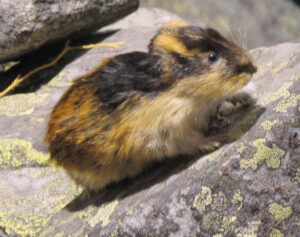Lemmings are small rodents, closely related to the common field mouse of more southern climes, these tundra mice inhabit the vast treeless areas of northern Canada and Alaska. They are best known for their lemming years when they reach high numbers over large areas of the Arctic and Sub-arctic. These large populations recur every three to four years and because many other animals depend on lemmings for food their impact is a dominant feature of animal life on the tundra.
They resemble small guinea pigs in overall proportions, having very short tails and small ears. When full grown they are about five to six inches long and weigh about two or three ounces. Lemmings are active all year and don¹t hibernate in winter, instead, they burrow under the snow, taking advantage of the insulation. When the air temperature is -60 F, the temperature under a 24 inch layer of snow may be as high as +20 F. Their winter nests, constructed of finely shredded grass, resemble hollow balls of hay and when the snow melts in spring are very conspicuous.
Their winter coats are longer and denser than their summer coats and the shortness of their legs, ears and tail minimize heat loss from body extremities. During the summer lemmings build their nests underground in tunnel systems which they dig in the soil as it thaws. Three species of lemmings inhabit Alaska tundra, the brown lemming (Lemmus sibiricus), collard lemming (Dicrostonyx torquatus), and the northern bog lemming (Synaptomys borealis) . The collard lemming has also been called the varying lemming because, unique among rodents, it changes color to adapt to winter¹s white environment. The reproductive rate of lemmings is very high. Breeding usual occurs from March to September, although in some years, lemmings breed all year round, except for brief periods during the spring melt and autumn freeze. This year-round breeding seems to presage a population peak.
One of the most widespread misconceptions about lemmings is that they regularly commit mass suicide to relieve their overpopulation problems. Rather than some orchestrated migration to the sea (most lemmings live too far from the ocean to make this possible!) a number of factors contribute to an abrupt decrease in their numbers. The cycle of predator numbers increases in direct response to lemming abundance. For example, Arctic foxes, weasels, and Snowy Owls kill lemmings in large numbers and show population changes paralleling the lemmings. Also, lemmings exhaust their food supply when they become very abundant, and die of starvation and malnutrition. The fact that crowding and stress is detrimental to the health and survival of an individual lemming has been documented (as it has in many other species as well) resulting in hormonal imbalances and increased aggressiveness. Individuals seldom live more than a year or two in the wild and with the high reproductive rate, a complete turnover in the entire lemming population can occur in a year or two.
Like most other small rodents at birth, young lemmings are blind, deaf, wrinkled and pink and weigh less than 4 grams. They develop quickly and are weaned between the second or third week of life. Juvenile males typically mature at about five weeks of age. One female in captivity bore six litters in twenty-two weeks, but in the wild females probably bear litters every sixty-seven days through spring and summer.
Lemmings feed primarily on plants such as grasses, sedges, seeds, willow bark, bearberry and cottongrass. Insects and meat may be eaten when available and there is some evidence that lemmings are cannibalistic when food is scarce.
One of the native names for lemmings is kilangmiutak, which means one-who-comes-from-the-sky. The legend of lemmings falling from the sky is common from the eastern Canadian Arctic to western Alaska, and is also found in Scandinavia. It probably arose because of the sudden appearance of lemmings when the snow melts in the spring of a peak population year.
Though lemmings themselves are not of direct economic importance, their importance to the web of life on the tundra is dramatic and enduring, sustaining owls, foxes, wolves, wolverines, weasels, mink, and marten through the winter. A population decline will certainly effect the economics of the trapping industry but will also produce an increase of Snowy Owl sightings in the northern states of the Lower 48 to the delight of many bird enthusiasts. In addition, these burrowing animals help aerate the soils and fertilize the earth with their droppings. Time after time, the tundra will bustle with activity for a brief period before the respite that comes when the lemming-year passes.




